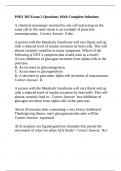,PCBIS Study Guide EXAM QUESTIONS
AND ANSWERS 100% ACCURATE!
Acquired TBI - ANSWER Occurs after birth, is not hereditary, congenital, degenerative
or induced by birth trauma. The injury results in a change in neuronal activity, which
affects the physical integrity, metabolic activity, or the functional ability of nerve cells in
the brain.
Traumatic Brain Injury - ANSWER An alteration in brain function, or other evidence of
brain pathology caused by an external force.
-Inertial forces
-Impact injuries (closed vs. open head injuries)
Characteristics of mTIBI - ANSWER Can either have brief or no loss of consciousness
and its presentation may demonstrate vomiting, lethargy, dizziness, and inability to
recall what just happened.
Moderate TBI - ANSWER Will be marked by unconsciousness for any period of time up
to 24 hours, will have neurological signs of brain trauma, including skull fractures with
contusion or bleeding. and may have focal findings on an EEG or CT scan.
Severe TBI - ANSWER Marked by a period of loss of consciousness of 24 hours or
greater.
Incidence of TBI in US - ANSWER 17.1 per 100,000
(2.5 million people in 2010 sustained a TBI, of these 2.5 million:
-53,000 deaths (2%)
-284,000 hospitalizations (11%)
-2,214,000 emergency department visits (87%)
Chronic conditions caused or accelerated by TBI - ANSWER Epilepsy: TBI is a major
cause of this as they are 1.5-1.7x more likely to develop it. (35-65% of pts will
experience this after one week post injury).
-SUDEP= sudden death in epilepsy (20x more likely than the general population)
CTE: Begins very slowly with deterioration in concentration, attention, memory,
judgment. best treatment is prevention. Develops from repeated blows from the head.
,Alzheimer's Disease: The worse the TBI the more likely it is to occur. Any history of
head injury will double the risk for AD.
Commission on Accreditation of Rehabilitation Facilities (CARF)= has specific standards
for brain injury programs.
Ramifications of Olmstead Decision - ANSWER July 1999 the courts ruled that two
women must be granted the option to live in the community.
-Gradually challenged federal, state and local governments to develop more
opportunities to be served through cost-effective community based services.
-We must provide services in the most integrated setting possible/appropriate.
-Grants and initiatives to make living in the community a reality
-Resulted in person centered planning where individuals are supported to be as
independent as possible and participate in things that they choose.
The Model Systems of Care - ANSWER The TBI model systems develop a model
system of care and maintain a standardized national database for innovative analysis of
treatment outcomes.
-Conduct research to demonstrate the course of recovery and outcomes
-Creates centers that must have a system including emergency care, acute neuro-
trauma management and rehabilitation.
-Tries to identify what treatments can improve rehabilitation outcomes, which are most
effective and which improve vocational outcomes. Additionally looks at predicting long-
term outcomes, and the relationship between cost of care and outcomes.
mTBI - ANSWER Also known as a concussion.
-Can come from contact sports, work-related injury and military conflicts.
-Need to pay close attention to the symptoms
-Incidence= 75% of all TBIs (1.1 million people each year).
-Definition= A traumatically induced physiologic disruption of brain function with one of
the following:
1. Any period of LOC
2. Any loss of memory before or after the incident
3. Any alteration in mental state
4. Focal deficits that do not exceed LOC of 30 mins, GCS of 13-15 and PTA not greater
than 24 hours.
5. Normal brain structure on a CT/MRI
, -Causes= acceleration-deceleration, strikes, blasts, diffuse axonal injury (axonal
shearing).
Neuroendocrine Disorders: Dysfunction of pituitary gland (30% of mod-severe), Growth
hormone deficiency/insufficiency (20% of Mod-Severe), low thyroid function (5%),
Gonadotropin (weakness, premature menopause).
Incontinence: TBI affects the cerebral structures that are controlling bladder storage and
emptying functions. "Neurogenic Bladder".
Standards for Rehabilitation Facilities - ANSWER Joint Commission Accreditation=
gold standard for hospitals, home care agencies and nursing care centers. Is awarded
for 3 years, focuses on staff qualifications and competency, patient rights, infection
control, and use of data etc.
-Symptoms: Cognitive changes (attention, multi-tasking, memory, emotional and
behavioral control), Frontal release (disinhibition, lability, depression), fatigue, affected
sleep patterns, changes in vision (eye movements, blurred vision, weak muscles)
*Headaches are the most common complaint and the primary reason for seeking
medical intervention.
-Neck pain, dissiness and poor balance, disorders of the inner ear, CNS
musculoscelatal system or all.
Reducing Disability from mTBI - ANSWER -Patient education about symptoms and
recovery
-Addressing the initial symptoms is critical to long-term recovery.
-Address initial symptoms that could create potential hazards for the individual (such as
poor balance) is crucial for long term outcome.
-Encourage an optimistic outlook, while promoting their physical safety and
psychological well-being.
-Slow resumption of normal activities (2-4 weeks).
PPCS incidence and treatment plans - ANSWER Post-Concussion Syndrome (PCS)- a
controversial term because they don't want it called a syndrome so the preferred term is
persistent post-concussive symptoms (PPCS).
PPCS is the persistance of symptoms weeks to months after a mTBI. This is present in
10-15% of mTBI patients.





